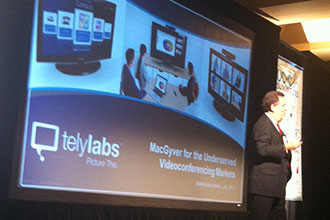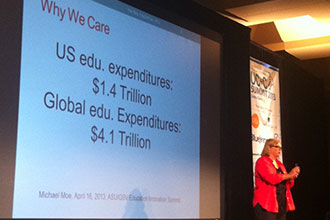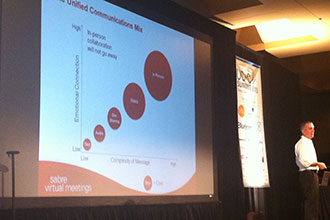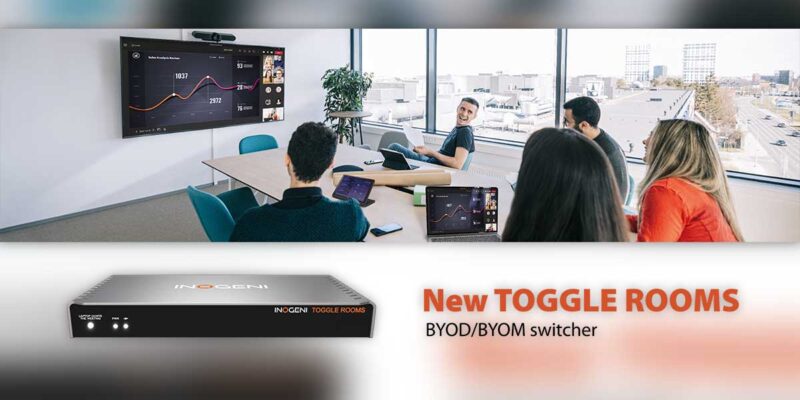A Review of the Wainhouse UC&C Summit
 By Darcy Harrell
By Darcy Harrell
CEO, Total Marketing
The palatable excitement from June’s InfoComm is slowly starting to wane. The thrill of new technology and product introductions, as well as the entrance of new market players, has been replaced as the doldrums of the everyday demo, quote, close rhythm takes over. In North Texas, it’s hot… and I don’t mean mildly hot, I mean burn yourself on your leather seats everyday kind of hot. So, when an opportunity presented itself to escape to Northern California to expand my knowledge of the unified communications (UC) and collaboration markets and current trends associated, maybe with a little networking on the side, I jumped at the chance.
I’ve been a dedicated follower of Wainhouse Research for many years. Most recently, I’ve followed closely the projections and trends specifically around the videoconferencing industry, which has continued to grow in size and also in recognition as new players have entered the last few years. As video has become more of a mainstream technology, more enterprise entities are now incorporating videoconferencing into their overall UC or collaboration strategy.
Wainhouse Research puts on an annual event billed as “the major unified communications and collaboration (UC&C) event in North America,” offering participants “the perfect meeting place to learn the latest developments in the industry, hear from world-renowned analysts and develop collaborative strategies for 2013 and beyond.”
 Wainhouse has been putting on these events for over a decade and each year, according to organizer Alan Greenberg, the event has grown in size and as well as quality of attendees. My experience was that of an intimate gathering (sub-200) of a wide range of UC professionals, each of whom brings a unique perspective to the industry and is genuinely vested in its future.
Wainhouse has been putting on these events for over a decade and each year, according to organizer Alan Greenberg, the event has grown in size and as well as quality of attendees. My experience was that of an intimate gathering (sub-200) of a wide range of UC professionals, each of whom brings a unique perspective to the industry and is genuinely vested in its future.
There were also a host of manufacturers and software providers including relative newcomers to the industry: Mersive, showcasing its Solstice product, as well as TelyLabs and its sub-$1000 room-based codec.
Most of the additional attendees included a host of service providers and a handful of end users. Noteably absent were the AV players as less than a handful of recognizable integrators and consultants were in attendance.
What I liked about the format was the small numbers encouraged a great deal of interactivity amongst attendees. Presentations were interactive and included time for audience Q&A. The intimate nature of the event fueled this.
Presentation topics and discussion highlights included impact of BYOD/BYOA in the enterprise, the changing face of higher education, the impact of Microsoft Lync and the disruption of the videoconferencing market with new products and services.
 What I learned, or rather, what was emphasized throughout the conference was that the UC&C market is changing more now than it ever has before. We have moved from presentation-based corporate environments, designed by and for top executives to collaborative spaces, designed and demanded by the knowledge workers who utilize them for daily tasks. The large auditoriums and boardrooms are being enhanced (and sometimes replaced) with smaller “huddle” rooms where groups gather to collaborate on projects and ideas. Those huddle rooms need to connect to others, as well as the larger boardrooms and even to individuals. This evolution presents such a huge opportunity for technology integrators to work with these organizations on finding solutions that meet the needs of decision-based workflows as well as generational-based workplace demands.
What I learned, or rather, what was emphasized throughout the conference was that the UC&C market is changing more now than it ever has before. We have moved from presentation-based corporate environments, designed by and for top executives to collaborative spaces, designed and demanded by the knowledge workers who utilize them for daily tasks. The large auditoriums and boardrooms are being enhanced (and sometimes replaced) with smaller “huddle” rooms where groups gather to collaborate on projects and ideas. Those huddle rooms need to connect to others, as well as the larger boardrooms and even to individuals. This evolution presents such a huge opportunity for technology integrators to work with these organizations on finding solutions that meet the needs of decision-based workflows as well as generational-based workplace demands.
The main propeller of utilizing collaborative technology in the enterprise is no longer travel cost savings or green initiatives, but rather adapting to the way people WANT to work. Consumerization is the main driver of this. No one wants to book a room in advance, have the AV guy (or girl) on standby, read a manual or troubleshoot anything. They want to bring their device or devices and communicate as simply as FaceTime or Skype has allowed them to do so.
If the quick poll of Wainhouse attendees on devices in possession is any indication (the “winner” had six), enterprises and educational institutes need to focus not just on BYOD, but BYODs(!) and the more importantly, the bandwidth necessary to support.
The question is, what are people doing with all these devices and the applications associated (BYOA)? Smart phones and tablets have become our weapons — the “Swiss Army knife” of our daily lives, allowing for everything from calls and texts to gaming and social media. Wainhouse has been following how people use devices and the research shows a continual increase in usage for audio, web and videoconferencing on the device. Additionally, cloud archival, streaming and instant messaging are becoming much more prevalent through various free applications. For the enterprise, this means not only greater collaboration and sharing internally, but also the opportunity for more B2C communication. With the prevalent use of social media and everyone having advice and opinions, businesses must communicate directly with consumers to maintain relevancy.
So, with consumers at the enterprise level and their cultivation of these “weapons,” IT departments have not been equipped with the resources to support them. How do we, as hardware and service providers adapt to the needs of IT? This includes building more robust networks, providing products that not only address the disparateness of devices, but also provide metrics/analytics on usage and adoption. Today, integrators have numerous tools available to provide these kinds of services, but you must be engaged with the right people and asking the right questions to have the right opportunities.
What about higher education? The current administration has a major emphasis on accessibility of post-secondary education for all Americans. President Obama set a goal that by 2020, America would once again have the highest proportion of college graduates in the world.
 Ellen Wagner, executive director of WCET likens this “Edudotcom Boom” to similar booms (and later busts) the U.S. has experienced in technology and real estate. Today, government subsidized debt fuels much of higher ed growth. Consumers are also bearing the weight of cost increases. In fact, according to the Federal Reserve Bank of New York, student loan debt continues to grow, now surpassing credit card and auto-related debts in the U.S. How will higher education institutions keep up with the demand while still remaining relevant AND affordable? For those with commercial interests in higher education, be aware of trends towards MOOCs (Massive Open Online Courses) and competency-based learning. These trends move away from the traditional classroom environment, no matter how “tech-savvy” those rooms might be, and into a virtual environment that’s more accessible to more students.
Ellen Wagner, executive director of WCET likens this “Edudotcom Boom” to similar booms (and later busts) the U.S. has experienced in technology and real estate. Today, government subsidized debt fuels much of higher ed growth. Consumers are also bearing the weight of cost increases. In fact, according to the Federal Reserve Bank of New York, student loan debt continues to grow, now surpassing credit card and auto-related debts in the U.S. How will higher education institutions keep up with the demand while still remaining relevant AND affordable? For those with commercial interests in higher education, be aware of trends towards MOOCs (Massive Open Online Courses) and competency-based learning. These trends move away from the traditional classroom environment, no matter how “tech-savvy” those rooms might be, and into a virtual environment that’s more accessible to more students.
Wagner encourages us to think like an “educatian” vs. an educator, and look at the mission and vision of the higher education institutions (not to mention backing government policies) when developing technology maps and plans for the future. Recording, streaming and archiving of content will continue to be of monumental importance for higher education to scale. Of lesser importance will be the institution in which one attends (sorry, Ivy League), but rather what a student can perform based on what he/she has learned. No matter how many fewer boxes it takes to set up the AV in a classroom today, in order to plan for the future, we must help colleges and universities to understand how to engage students in new and unique ways for scalability and affordability.
Videoconferencing certainly has a play here, in higher education as well as at the enterprise, to facilitate the face to face collaboration the market continues to demand. Interestingly enough, only 5 percent of said addressable market is even utilizing videoconferencing and studies have shown (thank you, Wainhouse) that even that 5 percent only uses videoconferencing technology 20 percent of the time. This begs the question, what industry would even exist with these metrics?
 The aforementioned FaceTime and Skype have brought the concept of videoconferencing out of the boardroom/classroom and to the masses, but we still haven’t seen the “pervasiveness” of video we’ve been talking about for so long. So, why now? With the evolution of video switching architectures and upgrades to ITU video standards (H.265), it’s possible to do more with less… less infrastructure, less cost, less bandwidth = more opportunity for video at multiple levels.
The aforementioned FaceTime and Skype have brought the concept of videoconferencing out of the boardroom/classroom and to the masses, but we still haven’t seen the “pervasiveness” of video we’ve been talking about for so long. So, why now? With the evolution of video switching architectures and upgrades to ITU video standards (H.265), it’s possible to do more with less… less infrastructure, less cost, less bandwidth = more opportunity for video at multiple levels.
Now, not every codec or application is standards-based, and today every environment seems to contain a heterogeneous assortment of hardware. Due to this, perhaps the most exciting development, or disrupter, is VaaS, Video as a Service. By eliminating the need for costly infrastructure (and the ongoing service agreements that accompany it), a campus or enterprise can associate video as an OppEx vs. CapEx expenditure. This also allows for cross-platform communication and functionality. At this year’s InfoComm alone, there were at least five new start-ups (supported mostly by ex-TANDBERG/Cisco executives and engineers) who were presenting varying levels of VaaS to the market – and those are just the ones focused on the AV market!
Unified communications is certainly driving video-based communications at the desktop level with simple user interfaces and mobile applications. Microsoft is leading the way with Lync in terms of market share in this space. Video isn’t something that has been quite as widely adopted here, although the opportunity is there. Today, the bandwidth required for quality of calls as well as the necessary peripherals keep the video piece from wider adoption. A huge opportunity is development of UCaaS to seamlessly integrate the video, audio and web portions of conferencing to a more robust system, thus creating a more fluid user experience.
Overall, I believe the future of UC&C for technology integrators is bright. We must learn how to take what we know and apply it to the future when we develop technology plans for our customers. For the most part, a customer doesn’t know what’s possible unless you help them see how technology can solve their problems today and meet their goals for the future, even assisting in those goals as true partners do.
Please take the time to explore Wainhouse’s site for further insight into this expanding industry. Create a user account and register at cp.wainhouse.com for access to press releases, forecasts and whitepapers. And plan to attend next year’s summit! AV is a huge part of the collaborative technologies and we, as AV professionals, need to further engage in the opportunities associated.





